Donderdag 27 Juni 2013

Tentoonstelling: Onverwachte ontmoetingen
Het Tropenmuseum brengt een ode aan zijn eigen verzamelingen met de tentoonstelling Onverwachte ontmoetingen. Verborgen verhalen uit eigen collectie.
Een Afrikaans krachtbeeld ontmoet een Apple computer en een kunstwerk met portretten van Marlene Dumas een Duitse staalkaart met veertig verschillende oogkleuren.

Josiah Onemu - Beelden van een bruggenbouwer
Beeldhouwer en kunstenaar Josiah Onodome Onemu (1945) is afkomstig uit Nigeria. Hij woont en werkt al tientallen jaren in Nederland. Deze expositie toont een overzicht van zijn brede oeuvre, waarvan een deel in beheer is van het Afrika Museum en een deel bestaat uit de privé-collectie van de kunstenaar. Vruchtbaarheid, het samenspel van tegendelen, lijden en wanhoop, hoop en beloftes, verandering en afscheid – de grote thema’s van het leven worden in het werk van Josiah Onemu nu eens sober, tot de essentie gereduceerd, dan weer verhalend in beeld gebracht. Hoe verschillend de uitwerking ook kan zijn, het onderwerp heeft altijd betrekking op mens en maatschappij.
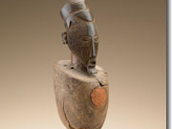
Earth Matters: Land as Material and Metaphor in the Arts of Africa
First major exhibition to examine the conceptually complex and visually rich relationship between African artists and the land upon which they live, walk, and frame their days. Approximately 100 artworks are on view in five thematic sections. For the first time, five artists create land-art installations in the Smithsonian gardens. Drawing upon a rich literature related to Earth shrines and religious organizations, this exhibition also contributes new and ground-breaking research on contemporary earthworks in Africa.
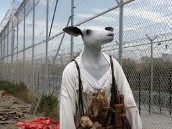
Surveys - Jane Alexander (South Africa)
While Jane Alexander’s figures are, in many ways, emblems of monstrosity, they are oddly beautiful. Her creatures expose the human animal for all it is and all it could become. Though clearly concerned with social issues, Alexander’s sculptural installations and photographs do not judge, nor do they convey a particular political or moral standpoint.
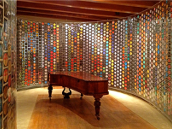
Labels - Siemon Allen (installation)
Siemon Allen’s Labels is a large architectural installation displayed in the museum’s Music Room. This visual memorial to South Africa’s rich musical past features 5000 photographs of record labels inserted into a suspended clear plastic curtain. The site-responsive installation has been configured to converse with part of the museum’s collection of historical artifacts and meanders through the space amongst the musical instruments and clocks, to form a number of intimate accessible enclosures. The exhibition is a historical record, a chronological discography of select labels from Allen's archive.
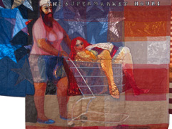
Hassan Musa - Installation, Assembled textiles
Musa is one of the most important contemporary artists of both Arabic and African heritage. Musa’s work approaches Western civilization as subject matter by referring to its iconography, thus questioning North/South relations and the dialogue between cultures. Always connected to the contemporary actuality, his works express at the same time his dual African and Oriental identity. This “identity” is also reflected by Musa’s role as an acclaimed calligrapher.
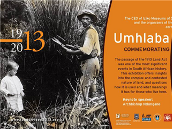
Umhlaba 1913-2013 Commemorating the 1913 Land Act
The Land Act of 1913, and associated legislation that was to follow during the apartheid period, had a devastating effect on the country and on the lives of millions of black South Africans. This photographic exhibition gives visitors the opportunity to follow a century-long journey into the history of the land, into land struggles, forced labour and child labour, removals, and last ditch stands. Historical photographic material gleaned from archives is exhibited alongside modern and contemporary work in new ways to explore the romance with and realities of the land, both in the past and the present.
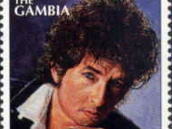
ASC Exhibition: Music on African stamps: Western music
Music as an expression of national identity is a common theme on stamps. That was also the case with the stamps of the previous Music-on-African-stamps exhibition. However, the stamps of the present exhibition show a very different picture, which has nothing to do with national identity: European composers and western “heroes of popular music”. Stamps showing European composers like Ludwig van Beethoven, Igor Strawinsky, Johann Sebastiaan Bach, Georg Friedrich Händel, Wolfgang Amadeus Mozart, black music heroes like Louis Armstrong, Billy Holiday, Muddy Waters, Mahalia Jackson, Lionel Hampton and Jimmy Hendrix and white music heroes like Elvis Presley, The Beatles, Jerry Garcia, Janis Joplin and Bob Dylan.

Hillie de Rooij - Myopia (fotografie)
Hillie de Rooij stelt zich de vraag hoe stereotiep en clichématig ons beeld van Afrika is, en hoe dit beeld tot stand komt. Ze onderzocht hoe Afrika verbeeld wordt in het westen en gebruikte dit onderzoek om Afrika opnieuw te construeren in het project Myopia. Het werk van De Rooij laat ons nadenken over representatie en confronteert on met onze eigen blik. Onderdeel van Digging Till The Sun Goes Down - eindexamenexpositie van vijf fotografiestudenten van AKV | St. Joost.

Art-Zuid 2013 - grote Afrikaanse inbreng
In de derde editie van de inmiddels befaamde tweejaarlijkse beeldenroute in Amsterdam-Zuid spelen Afrikaanse kunstenaars een grote rol: Kader Attia (Algerije), Romuald Hazoumè en Dominique Zinkpe (Benin), Mickaël Bethe-Selassié (Ethiopië), Kofi Setordji, El Anatsui en Atta Kwami (Ghana), Jems Robert Koko Bi (Ivoorkust), Pascale Marthine Tayou (Kameroen), Abdoulaye Konaté (Mali), Sokari Douglas Camp (Nigeria), Oumou Sy (Senegal)
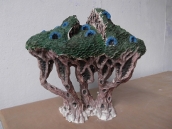
Tentoonstelling: Look on the bright side, met o.a. Esther Mahlangu & Adriaan de Villiers (ZA)
Net voor de zomer haalt SANAA met deze kunstenaars de zomer in huis. Wuivende bomen in een groen bos waar de tijd langzaam verstrijkt - de video Entre van Frans van Lent vult op groot beeld de ruimte in SANAA. Andrea Freckmann's kleurrijke schilderijen zijn een bizar spel met de ruimte waar mensen en objecten samen in wonen. De heldere geometrische vormen van Esther Mahlangu (ZA) brengen de frisse beeldtaal van Ndebele binnen. De sculpturen van Adriaan de Villiers (ZA) zijn verwaaide bomen gestold in aardewerk die nu bij SANAA de etalage vullen.
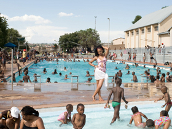
My Joburg - exhibition
Johannesburg is a megapolis with a population of more than 6 million. It is heterogeneous, composed of trendy areas, residential neighborhoods, townships… A productive artistic community has developed there, with a number of photographers as well as painters, sculptors, performing artists and video-artists. This exhibition looks at the art scene in a city where history has been on the march since the abolition of apartheid and the first democratic elections in 1994.
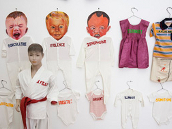
Meschac Gaba - Le Monde (exhibition)
Exhibition comprises works that he made for the recent Benin Biennale as well as an installation titled La Mode en Miniature. The latter takes the form of a shop of babies' and children's clothes, made in Cotonou, Benin, and displayed on painted dummies, also from Cotonou. At first glance, the installation appears childlike and sweet, yet a closer look reveals that the embroidered texts on the colourful clothes are violent, disturbing and disconcerting words and phrases, a reminder of children's vulnerability to certain phenomena in our society.
GO-SLOW: Diaries of Personal and Collective Stagnation in Lagos - Contemporary Photography
Group exhibition of photographic works by ten Nigerian artists who are among a new generation of African photographers that explore unique visions, strong emotional and aesthetic perspectives to tell their own stories and challenge assumptions about the African continent. Each of the artists is widely traveled and well exposed to Western art modernism both by training and contact. Each represents a resonant voice, one that achieves it's own distinction and clarity amidst changing realities.

Lines, Marks, and Drawings: Through the Lens of Roger Ballen
Roger Ballen (b. 1950) has been shooting black-and-white film for nearly a half-century. A New York native, he has lived in South Africa for more than thirty years. Ballen's photographs of rural Afrikaners in their homes and urban-based "outsiders" in windowless rooms quickly became distinguished for their interior arrangements and the events that transpired among the people, animals, and furnishings within. Ballen's interest in line-whether of coat hangers, electric wire, or marks made on walls-has been constant.



